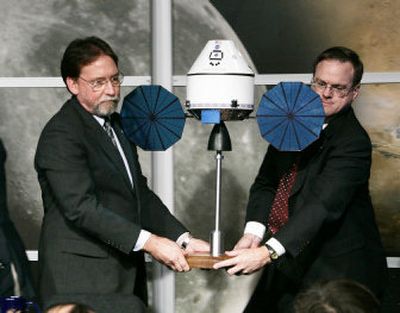NASA hires firm to build spacecraft

WASHINGTON – Lockheed Martin Corp. won a multibillion-dollar contract Thursday to build a space vehicle to replace NASA’s shuttles, put a human on the moon for the first time since 1972 and be the precursor to a manned ship to Mars.
The award marks NASA’s most concrete step to fulfill President Bush’s two-year-old, $230 billion promise that the space agency would return astronauts to the moon and restore excitement about space exploration. NASA has planned to replace the shuttles since the mid-1980s, and has spent almost $5 billion to do so, with little success so far.
“It’s just thrilling, for all of us,” said Caris “Skip” Hatfield, NASA’s project manager. The vehicle, known as Orion, is the embodiment of the “very future of human spaceflight,” he said.
Orion will look somewhat like the three-man Apollo command module but will carry as many as six astronauts. Like the shuttle, Orion will be able to carry cargo to and from the International Space Station.
Orion is expected to make its first manned flight by 2014, four years after NASA’s three operating shuttles are retired. NASA hopes for a moon landing by 2020.
Unlike the shuttle, which lands like an airplane on a runway, Orion will descend with the aid of a parachute to landings in the ocean or on land. NASA plans to build two of the vehicles, one for manned flight and the other for unmanned. After judging how often the spaceships can be reused, the agency will decide how many more to buy, Hatfield said.
“We’re just tickled, honored to be chosen,” said John Karas, Lockheed’s vice president for space exploration. The program could eventually be worth nearly $8 billion to the Bethesda, Md.-based company.
The Government Accountability Office, the investigative arm of Congress, has already questioned NASA’s approach to Orion. The space agency says it is taking a conservative approach, relying on the familiar Apollo design and proven spacecraft technology.
It was a somewhat unexpected win for Lockheed, the Pentagon’s largest contractor. The other competitor, Northrop Grumman, was considered the front-runner because along with its subcontractor, Boeing Co., it has been involved with all of the country’s manned space programs. Lockheed also has had a long history with NASA, though not always positive and not predominantly with manned vehicles.